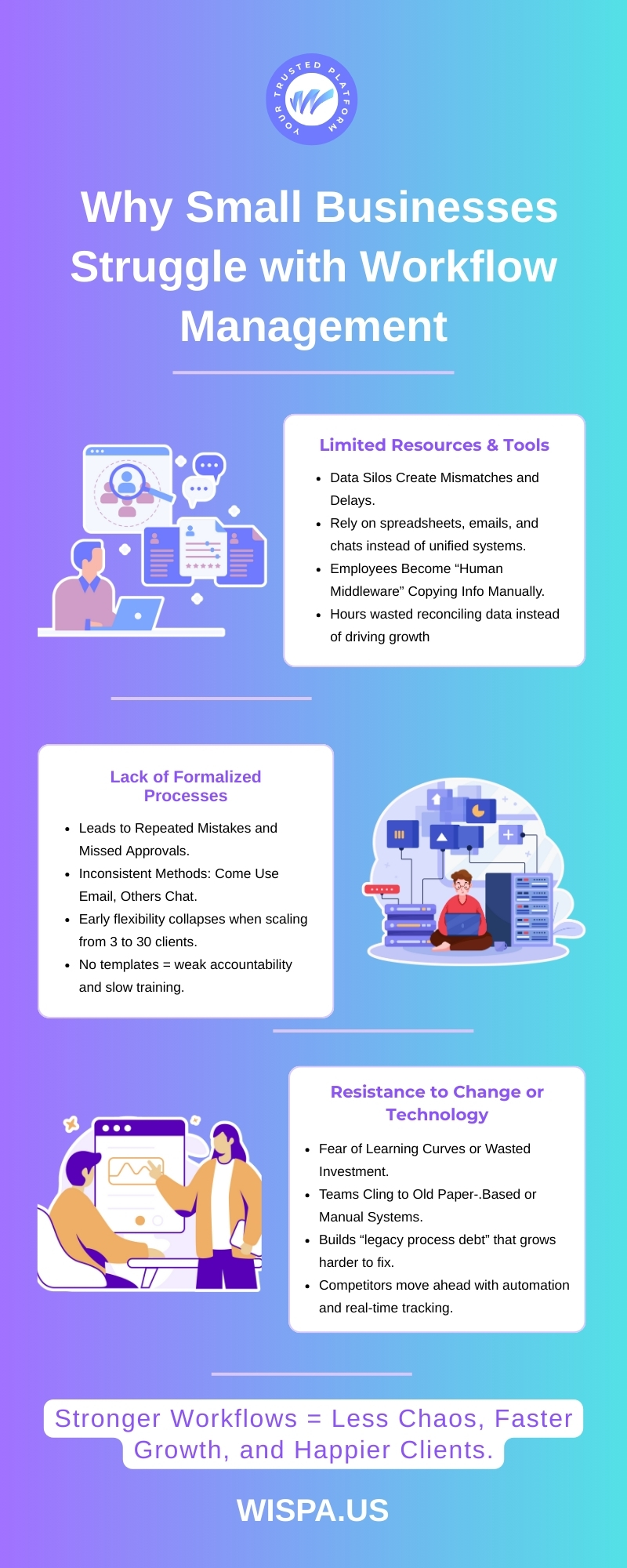
10 Common Workflow Challenges Small Businesses Face (And How to Solve Them)
Running a small business often feels like solving a puzzle. The pieces keep shifting, and you’re expected to make them fit. Owners juggle tight budgets, small teams, and rising client demands. What feels manageable with five employees can overwhelm you at twenty. A single missed email, a delayed approval, or a misplaced file can quickly snowball into lost revenue and unhappy customers.
In the United States, there are 33.3 million small businesses. They make up 99.9% of all businesses, and most share the same challenge: underdeveloped workflow management. Weak workflows ripple across every operation, slowing progress, straining collaboration, and limiting growth.
Workflows aren’t simple checklists. They’re structured sequences of tasks, dependencies, and roles that move work from start to finish. When those sequences aren’t clear, you see delays, confusion, and wasted effort. In this article, let’s walk through the ten most common workflow challenges small businesses face, why they happen, and how to fix them.
Why Small Businesses Struggle with Workflow Management
Small businesses often face hidden barriers that make managing workflows harder than it should be.

Limited Resources and Tools
Most small businesses don’t have enterprise project managers or high-end IT systems. Instead, they rely on spreadsheets, emails, and messaging apps. While affordable, these tools create silos that slow down operations. Imagine a retail startup tracking sales in Excel, inventory in Google Sheets, and shipping updates in WhatsApp. Eventually, mismatches happen, delays creep in, and customers feel the impact.
Without integration, employees become “human middleware,” manually copying data between platforms. Every transfer risks errors and duplicates. Instead of focusing on growth, teams spend hours reconciling information. Without a unified system, efficiency becomes nearly impossible.
Lack of Formalized Processes
In early stages, small businesses often thrive on flexibility. They use quick chats, gut instincts, and fast fixes to move forward. That works with three clients but crumbles when you are managing thirty. For example, one project manager might send briefs by email, while another prefers chat. This inconsistency leads to repeated mistakes and missed approvals.
From a technical view, skipped steps or unordered actions weaken accountability. Without templates or process maps, new hires struggle to understand expectations. Training takes longer, and mistakes become harder to prevent.
Resistance to Change or New Technology
When resources are limited, change feels risky. Teams often resist new tools because they fear steep learning curves. Others doubt the return on investment or cling to familiar routines. For instance, an accounting firm still using paper-based approvals may hesitate to adopt digital systems, even while delays pile up.
This reluctance creates something called “legacy process debt.” The longer outdated workflows remain in place, the harder and more expensive they are to fix later. Meanwhile, competitors adopt automation, track performance in real time, and move ahead.
Major Workflow Challenges Small Businesses Encounter
Inefficient workflows don’t just waste hours, they limit trust and revenue. Small businesses face unique workflow struggles that slow growth. Here are the biggest challenges you need to know.

Workflow Bottlenecks that Slow Down Progress
Bottlenecks often form when processes depend on a single approval or key knowledge holder. If that person is away, everything stalls. Picture a consultancy where every contract needs one partner’s signature. A single business trip can freeze multiple projects.
Technically, bottlenecks serialize workflows. Tasks line up in a queue instead of running in parallel. This blocks scalability and frustrates employees. Clients also lose trust when timelines slip repeatedly.
Solution: Implement a system with conditional logic workflows where approvals cascade or reassign automatically. With proper setup, tasks keep moving even if someone is unavailable.
Process Inefficiencies that Waste Time and Resources
Manual data entry, duplicate reports, and disjointed tools cost valuable time. For example, an e-commerce store exporting Shopify orders to Excel before emailing them to couriers faces risks at every step.
These inefficiencies stem from non-integrated environments. Without APIs or automation, employees act as intermediaries, slowing everything down and multiplying errors.
Solution: Opt for a workflow management tool that helps you automate repetitive transfers and create a single source of truth. Connected workflows update information across systems in real time helps save hours and prevent mistakes.
Poor Team Collaboration and Communication Gaps
Collaboration breaks when communication is scattered. A copywriter working from an email brief while the designer uses chat updates leads to mismatched deliverables.
This happens because information is trapped across different platforms like Slack, Gmail, and shared drives. Important updates get buried, and accountability fades.
Solution: Embed communication into the workflow itself. Every task should carry its context: files, chats, and comments linked directly. This reduces app-switching and ensures collaboration is tied to work progress.
Unclear Task Ownership and Accountability
In small businesses, employees wear multiple hats.Without explicit task ownership, responsibilities slip. For example, two HR team members assuming the other scheduled interviews can leave candidates waiting weeks.
From a workflow perspective, tasks become orphans, initiated but lacking a responsible owner to complete them. This undermines accountability and slows operations.
Solution: Every task must have a single owner, even in cross-functional teams. Roles, deadlines, and dependencies should be clearly defined. Automated reminders prevent tasks from being overlooked.
Difficulty Adapting to Process Changes or Scaling Workflows
What works for five clients collapses at fifty. A tax consultancy built around ad-hoc processes may suddenly drown in paperwork when demand surges.
Technically, this occurs because workflows lack modularity and scalability. Without templates, cloning, or process branching, teams cannot replicate successful workflows at scale.
Solution: Adopt modular workflow design. Create reusable templates that adapt to different clients or departments. This ensures consistency while maintaining flexibility for growth.
Lack of Visibility Into Work Progress
Many small business leaders rely on manual updates, emails, meetings, or status calls, to understand progress. By the time an issue surfaces, it’s often too late. A construction contractor may only discover material shortages once deadlines are already missed.
The core issue is the absence of real-time dashboards. Without them, leaders can’t see metrics, workloads, or delays as they happen.
Solution: Use systems that provide real-time tracking and reporting. Dashboards with progress bars, workload indicators, and alerts give leaders proactive control.
Inconsistent Processes Across Teams
When teams build their own methods, inconsistencies multiply. Imagine a law firm where one paralegal tracks cases in spreadsheets while another uses email. During handoffs, important documents inevitably get lost.
This fragmentation makes training harder and compliance audits stressful. Training new staff takes longer, and compliance audits become a nightmare.
Solution: Standardize workflows using templates and SOPs. This ensures uniformity across departments while maintaining flexibility for specific client needs.
Overdependence on Manual Tracking
Spreadsheets and handwritten logs may work for five tasks but become overwhelming to manage under larger loads. An IT services company manually logging tickets in Excel risks missed updates and delayed responses.
Manual tracking lacks error detection, status validation, and automation. It introduces human error and slows environments that demand speed.
Solution: Replace manual logs with automated task trackers. Choose a tool that offers built-in reminders, progress updates, and searchable histories ensure nothing slips through the cracks.
Client Expectations Outpacing Processes
Clients today expect instant updates, transparency, and faster approvals. Without workflow visibility, businesses scramble to prepare manual reports. A digital agency compiling campaign status from Slack, Trello, and email wastes hours that could be spent on strategy. By the time the report is ready, the data is already outdated.
This happens because client-facing dashboards or progress views are missing. Client approvals depend on printing, signing, and scanning documents
Solution: : Adopt workflows with client portals, shared dashboards, and built-in e-signature features. This builds trust and saves staff hours by automating updates.
Stagnant Workflows That Don’t Evolve
Workflows must evolve with the business. A logistics startup facing repeated delivery delays may never identify root causes because workflows remain static.
Technically, stagnant workflows lack analytics and continuous improvement loops. Leaders operate blindly, unable to refine or optimize processes.
Solution: Continuously monitor workflows using completion rates, bottleneck reports, and workload distribution metrics. Regular iterations ensure workflows stay aligned with business goals.
Proven Strategies to Overcome Workflow Challenges
Step 1: Identify and Eliminate Workflow Bottlenecks
Start with process mapping. Visualize each step, owner, and dependency. By tracking timelines, businesses can identify where delays consistently occur. For example, a dashboard revealing all approvals stalled under one manager highlights the choke point.
With real-time visibility, leaders can reassign tasks, parallelize approvals, or introduce automation that moves work forward without manual nudges.
Step 2: Implement Process Standardization for Consistency
Inconsistent processes erode quality and complicate training. By creating standard operating procedures (SOPs) and templates, businesses can ensure every project follows the same sequence.
For instance, a law firm handling cases through a standard checklist ensures no step, like document verification, is skipped. Technically, this requires workflow templates that can be cloned, adapted, and reused, giving structure without rigidity.
Step 3: Enhance Team Collaboration with the Right Tools
Effective collaboration is about visibility and context. When teams can see what others are working on, overlap reduces. For example, shared boards showing task status prevent duplicated work.
Utilize task-linked communication channels, comments, file attachments, and mentions tied directly to the task. This reduces data scattering and keeps discussions actionable.
Step 4: Assign Clear Roles and Responsibilities
Ambiguity kills efficiency. Each task should specify an owner, collaborators, and approvers. For example, a product launch may assign the marketing lead as owner, the designer as collaborator, and the CEO as approver.
This requires role-based task assignment with automated notifications. Dependencies ensure that tasks don’t progress until approvals are complete. This keeps accountability transparent and measurable.
Step 5: Continuously Monitor and Optimize Workflow Processes
Workflows aren’t static. As businesses evolve, so must their processes. Without monitoring, inefficiencies persist unnoticed. For example, a logistics company may repeatedly miss deadlines but fail to see whether delays occur in warehousing, transport, or delivery.
Technically, this requires workflow analytics: completion rates, average timelines, workload distribution. By measuring metrics, businesses can iterate, refining processes for speed and efficiency.
The Role of Workflow Management Tools in Streamlining Operations
Spreadsheets list tasks, but they don’t show dependencies or flow. Digital workflow management tools designed with Kanban boards, Gantt charts, and dashboards make workflows visible.
For example, a construction contractor managing three projects can instantly see which tasks are delayed and reallocate resources. This creates real-time project intelligence, allowing leaders to act before problems escalate.
1. Automate Repetitive Tasks to Improve Efficiency
- Manual reminders and follow-ups drain productivity. Automating them saves hours. For example, instead of emailing clients weekly updates, an automated rule can send progress summaries once milestones are reached.
- Workflow triggers work like dominoes: if condition X is met, action Y follows. This keeps transitions smooth without human effort, reducing delays and errors.
2. Supports Scalable and Flexible Processes for Growth
- Static systems break under pressure. As small businesses expand, workflows must adapt. A marketing agency adding new service lines can’t afford to rebuild processes from scratch.
- Scalable workflow management software for small businesses allow multi-project management, department-specific workflows, and client-specific variations. With templates and modular workflows, businesses can expand without chaos.
This enables horizontal scalability (multiple concurrent projects) and vertical scalability (adding depth and complexity to processes without redesign).
Conclusion
For small businesses, workflow management isn’t just about task lists. It’s about building resilience and efficiency. Weak workflows compound into missed deadlines, weak accountability, and dissatisfied clients.
The right platform workplace management tool transforms these vulnerabilities into strengths by unifying data, automating transitions, and scaling seamlessly as complexity grows.
Wispa stands out because it isn’t a single-function tool, it’s a comprehensive business operating system. With 21+ integrated modules spanning task management, CRM, HR, client support, communication, and AI-driven automation, Wispa eliminates the fragmentation caused by juggling multiple SaaS tools.
Leaders gain real-time visibility through dashboards, automated triggers that remove manual dependencies, and scalable templates that adapt as teams and service lines expand. In practice, this means fewer blind spots, faster decision-making, and workflows that flex with growth instead of breaking under it.
Want to know more?
Try Wispa free today to see how a unified workflow backbone can drive efficiency, accountability, and sustainable scale.
Frequently Asked Questions
The most common red flags include frequent delays, recurring missed deadlines, duplicated tasks, unclear accountability, and an over-reliance on manual updates to track progress.
Bottlenecks can be identified by mapping out processes, measuring task timelines, and monitoring where delays repeatedly occur. Once identified, automation and smart reassignments ensure tasks keep moving even when one step stalls.
Collaboration is critical because it allows tasks to transition seamlessly across departments, reducing overlaps and preventing missed steps. A centralized communication hub keeps every action contextual, traceable, and accountable.
Digital platforms with features such as boards, task assignment, file sharing, automation, and dashboards make workflows easier to manage.
Yes, because standardized and flexible workflows form the foundation for growth. By adopting scalable digital tools, small businesses can expand their operations without adding unnecessary complexity.




